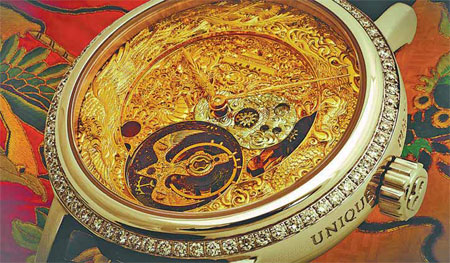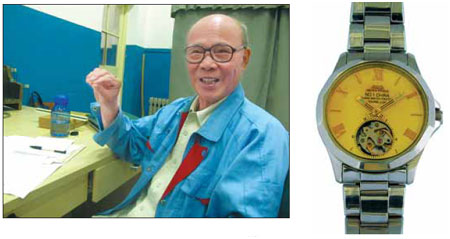The test of time
Updated: 2012-08-09 08:05
By Wang Kaihao (China Daily)
|
||||||||
|
"Playing Dragon and Phoenix" was made by Beijing Watch Factory for the luxury market. Provided to China Daily |
|
Above: Watch movement designer Xu Yaonan is one of nine national "master watchmakers". Wang Kaihao / China Daily Right: The first tourbillon made by Xu Yaonan. Provided to China Daily |
The nation's master watchmakers were late entrants in the luxury market and though they had high hopes of competing with the Swiss, the reality is more mixed. Wang Kaihao reports in Beijing.
The old Soviet-style Beijing Watch Factory was erected in Changping district more than 50 years ago. A giant statue of former chairman Mao Zedong stands at the front gate.
"It's almost the same as the day I first came here," says Xu Yaonan, 78, a watch movement designer who has worked at the factory since 1962, after graduating from Tianjin University. He majored in horologe machine manufacturing in the department of precision instruments.
"The watch manufacturing industry had just started in China at that time. We all wanted to make a contribution to the country."
China made its first watch, in 1955, in Tianjin. Watch factories mushroomed nationwide in the following years and Beijing Watch Factory was founded in 1958.
In June, China Horologe Association (CHA), the official organization supervising the development of the industry, presented the title of "Chinese Watch and Clock Masters" to 12 people nationwide for the first time in the Great Hall of the People. Xu is one of nine "master watchmakers".
As the son of a clock repairer in his hometown of Wuxi, Jiangsu province, Xu grew up with watch-making gadgets, which made him decide to follow in his father's footsteps.
"Everyone in the factory was so disciplined and we had a very ambitious slogan: 'The watch won't leave the factory if it fails to catch up with (those made in) Switzerland."
Xu joined a delegation for a light industry exhibition in Poland, East Germany and Romania in 1964, and was proud to see Chinese watches appreciated by visitors for the first time.
He was a member of a 15-people panel to design a "national unitary watch movement" in 1967. The brass movement with a diameter of 26.5 mm and a thickness of 4.4 mm was put into mass production in 1970s and is still made at some factories today.
A watch was one of the san da jian, or "big three pieces" (the others were a bicycle and sewing machine) that symbolized high living standards for ordinary Chinese families in the late 1970s. A Beijing-brand watch sold then for about 110 yuan, which was about two months salary for Xu at that time.
Xu says there were more than 3,000 employees at the factory in the early 1980s, and the only way you could get a job then was through personal connections.
Miao Hongbo, 47, is the general manager of the factory and says when he arrived in 1986, its heyday had just passed.
"The Japanese quartz watch came in and the whole industry began to go downhill," says Miao, looking sullen. "Mechanical watches were no longer the first choice for timing."
The factory had to rent land to neighboring schools to make ends meet in the following years. Meanwhile, many other manufacturers failed to pass the test of time.
Zhang Yamin, 58, is the former deputy head of Hefei Watch Factory in Anhui province. His factory spent large amounts of money introducing instruments from Switzerland in the mid-1980s but the expansion led to overcapacity and a switch to making quartz watches was made around 1990.
"But we couldn't keep down our costs as low as our Japanese counterparts'. The factory didn't have enough creativity and it got worse and worse."
The factory limped along for another decade and finally disbanded in 2005. Zhang now runs a watch-repair store.
According to CHA Vice-Chairman Zhang Hongguang, the country had 38 mechanical watch factories that could produce their own movements in the 1980s, but the number is just nine now.
In the 1990s, when the Chinese market opened up to numerous Swiss luxury brands, the movement designer Xu knew Chinese watches need to be updated.
He attended the Hong Kong-based watchmaker Kiu Tai-Yu's exhibition in 1994 and saw a tourbillon, which it was claimed, was the first made in China.
Tourbillon is a watch element that originally aimed to counter the effects of gravity for more accurate timing, but has now become a symbol for top-tier watches due to the highly demanding construction process. A tourbillon weighs no more than a swan feather but contains 72 parts.
"I thought, he is just a watchmaker like myself. Why don't I try?" he says.
For the first time, Xu decided to design his own tourbillon, but didn't have any books or models to reference.
"It's like drawing on a blank sheet of paper. I knew the theory of how a tourbillon worked, but that was all. "
He had a look at old pocket watches to get inspiration but it didn't work.
Xu then took one year to make a tourbillon, generally considered to be the first made in the Chinese mainland. However, this achievement did not attract heavy attention after its birth.
"Many people asked me why I went to so much bother to make a tourbillon," Xu says. "They think no matter how it helps make timing more accurate, it cannot beat quartz watches. They don't realize watches are no longer only for timing."
Xu made three tourbillon and waited eight years until Miao and other managers decided to enter the high-end market.
Xu led a team for 11 months to make the watch "Playing Dragon and Phoenix", which sold for as much as 1 million yuan ($157,000) shortly after Baselworld, the world's leading watch and jewelry show, in 2006.
Nevertheless, Miao confesses the high-end watch brand is unable to rival their Swiss counterparts. But he adds the Beijing watch has its own characteristics.
The factory began to make watches using enamel dial plates in 2006, which was then uncommon among domestic watchmakers and is still a major selling point of their product today.
"We don't have to be homogeneous with others," Miao says, while staring at the watch he wears, made in the factory.
The factory produces 80,000 mechanical watch movements every year, but only about 2,000 high-end watches with tourbillon.
"The luxury watches are meat, and the ordinary ones are rice. It's not healthy eating just meat without rice. We have to build a solid base," Miao says.
According to CHA statistics, 65 percent of watch turnover in the Chinese market comprises Swiss watches. Zhang Hongguang thus expects more support from domestic consumers.
"If we only pursue foreign luxury brands, our own watches will have no space," Zhang says, adding it's urgent to encourage a new generation of watchmakers.
Xu's major at Tianjin University, which has nurtured many of the country's watchmakers, was cancelled in the early 1990s. Newcomers to the factory can only learn skills as apprentices.
And the relatively low pay is not attractive. Some experienced craftspeople at the factory can earn 6,000 yuan ($942) a month, while most ordinary workers get just 2,000 yuan.
"Xu and several other old masters are like our spiritual leaders," Miao says. "But I really worry there are no youngsters who are able to take on their work."
Zhang Hongguang adds he is not sure whether they can select nine watchmakers who are qualified to be called "masters" next year. "They are artists rather than artisans," he says. "We have to rebuild a systematic training program, though maybe only one among 100 people has the talent to be an artist."
Contact the writer at wangkaihao@chinadaily.com.cn.
(China Daily 08/09/2012 page18)

 Relief reaches isolated village
Relief reaches isolated village
 Rainfall poses new threats to quake-hit region
Rainfall poses new threats to quake-hit region
 Funerals begin for Boston bombing victims
Funerals begin for Boston bombing victims
 Quake takeaway from China's Air Force
Quake takeaway from China's Air Force
 Obama celebrates young inventors at science fair
Obama celebrates young inventors at science fair
 Earth Day marked around the world
Earth Day marked around the world
 Volunteer team helping students find sense of normalcy
Volunteer team helping students find sense of normalcy
 Ethnic groups quick to join rescue efforts
Ethnic groups quick to join rescue efforts
Most Viewed
Editor's Picks

|

|

|

|

|

|
Today's Top News
Health new priority for quake zone
Xi meets US top military officer
Japan's boats driven out of Diaoyu
China mulls online shopping legislation
Bird flu death toll rises to 22
Putin appoints new ambassador to China
Japanese ships blocked from Diaoyu Islands
Inspired by Guan, more Chinese pick up golf
US Weekly

|

|








